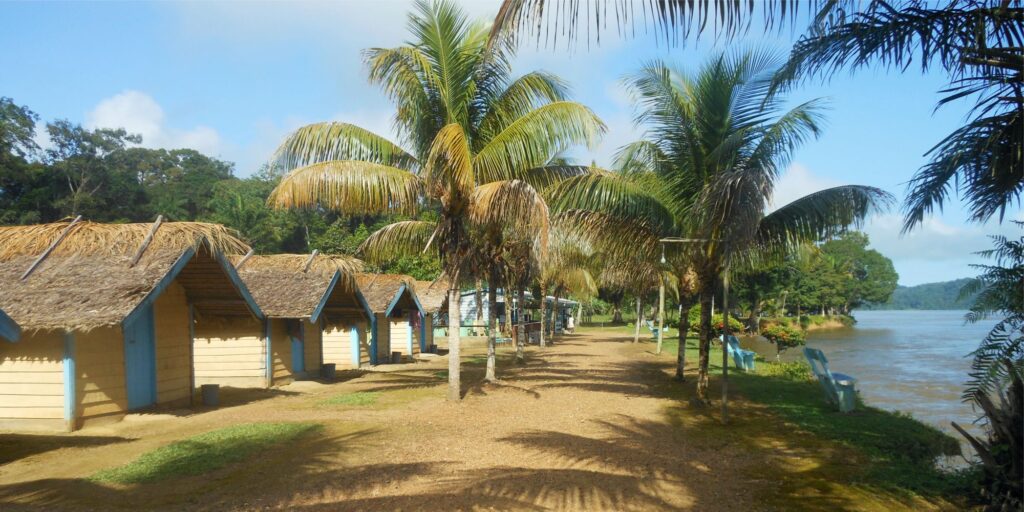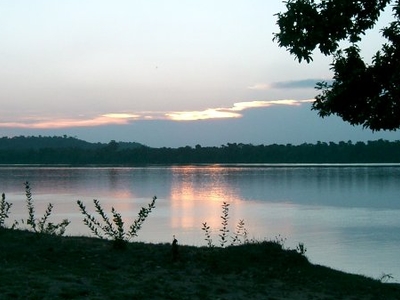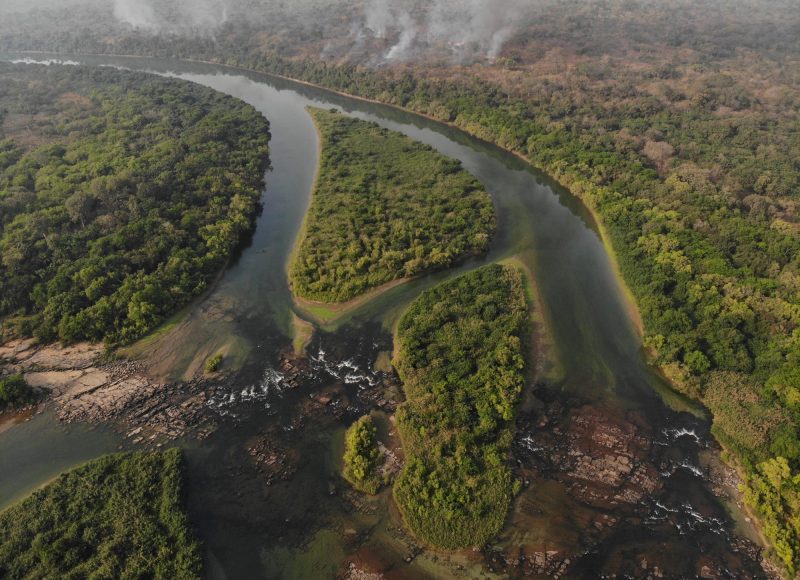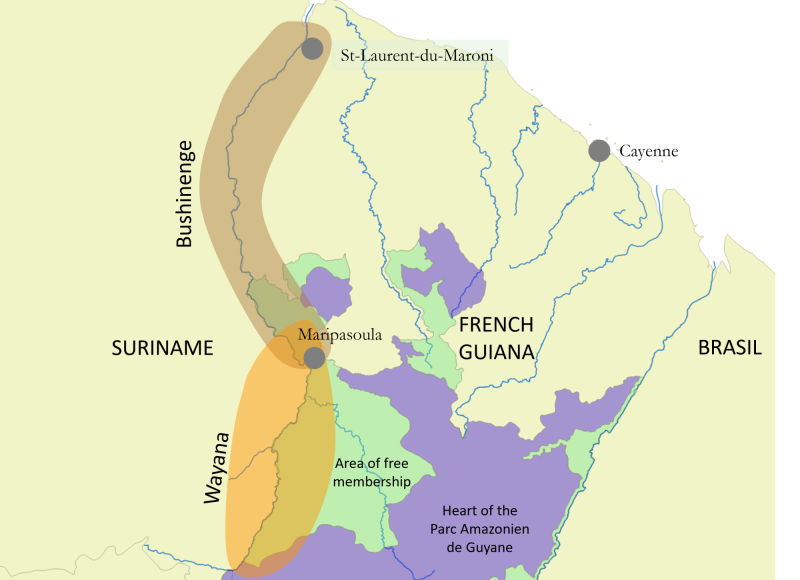Imagine yourself gliding on the tranquil waters of the Maroni River in Suriname, eyes wide with anticipation as you venture into uncharted territory. With the gentle breeze caressing your face and the rhythmic sound of the paddle cutting through the water, you are immersed in the enchanting beauty of this remote region. As you delve deeper into this tropical paradise, you will encounter vibrant indigenous cultures, breathtaking wildlife, and awe-inspiring natural wonders. So, grab your sense of adventure and embark on a journey unlike any other, where the Maroni River beckons you to uncover its hidden treasures.

Geography of the Maroni River
Location
The Maroni River is located in South America, specifically on the border between Suriname and French Guiana. It flows through the pristine rainforests and remote wilderness of the Amazon Basin, creating a natural border that separates these two countries. The river starts in the Tumuc-Humac Mountains in the southeast of Suriname and stretches for approximately 600 kilometers before it meets the Atlantic Ocean.
Size
With its length of 600 kilometers, the Maroni River is one of the longest rivers in Suriname. Its vast size and pristine beauty make it a significant natural landmark in the region. The river’s width varies along its course, from narrow channels to broader sections that resemble small lakes. Its depth also fluctuates, with some areas being shallow and others deep enough for large vessels to navigate.
Topography
The topography along the Maroni River is characterized by dense tropical rainforests, towering trees, and vast stretches of unspoiled wilderness. The river meanders through breathtaking landscapes, including rolling hills, rocky outcrops, and tranquil lagoons. The area is home to numerous indigenous communities that rely on the river for their livelihoods, as it provides them with food, transportation, and sustenance. The Maroni River’s diverse topography offers a unique and awe-inspiring experience for visitors interested in exploring its natural wonders.
Flora and Fauna of the Maroni River
Biodiversity
The Maroni River region boasts an incredible biodiversity, with a wide array of plant and animal species coexisting in its pristine ecosystem. The river’s lush rainforests harbor an abundance of plant life, including towering trees, vibrant orchids, and a myriad of medicinal plants. The diverse fauna includes jaguars, monkeys, caimans, and various bird species, such as colorful macaws and toucans. The Maroni River’s rich biodiversity provides a haven for nature enthusiasts and researchers alike, offering a unique opportunity to observe and appreciate the wonders of the natural world.
Endangered Species
Unfortunately, the Maroni River region is also home to several endangered species that face threats to their survival. Among these are the giant river otter and the manatee. These majestic creatures are at risk due to habitat destruction, pollution, and illegal hunting. Efforts are being made to protect and conserve their habitats, and raising awareness about their plight is crucial for their long-term survival.
Native Plants
The Maroni River region is renowned for its diverse range of native plants, many of which have significant cultural and medicinal value for the indigenous communities residing in the area. These communities rely on the river’s resources for their sustenance and traditional practices. Native plants such as the medicinal timbó vine and aromatic ajwain are integral to their cultural heritage. Exploring the Maroni River provides an opportunity to learn about these native plants and their importance in the local communities’ daily lives.
Indigenous Communities Along the Maroni River
Wayana People
The Wayana people are one of the indigenous communities that call the Maroni River region their home. They have a deep connection to the river and its surrounding forests, which they consider sacred. Traditionally, the Wayana are skilled hunters, gatherers, and fishermen, and their traditional knowledge of the river’s resources is invaluable. Visitors have the opportunity to immerse themselves in their vibrant culture, witness their traditional ceremonies, and learn about their traditional crafts, such as woven baskets and intricate beadwork.
Trio People
The Trio people, also known as the Tiriyó, have inhabited the Maroni River region for generations. They have a unique way of life and are known for their harmonious coexistence with nature. The Trio people practice subsistence agriculture, fishing, and hunting, relying on the river’s resources for their survival. Visitors can engage with them to gain insights into their sustainable way of life, experience their traditional dances, and purchase intricate wood carvings and woven hammocks, which are renowned for their craftsmanship.
Aluku People
The Aluku people, also known as Boni Maroons, are descendants of African slaves who escaped from plantations in Suriname during the colonial era. They established their communities along the Maroni River and have preserved their rich cultural heritage over the centuries. The Aluku have a unique blend of African and Amerindian traditions, which is reflected in their vibrant music, dance, and cuisine. Visitors can witness their traditional rituals, listen to the rhythmic beats of their drums, and savor their traditional dishes, such as gumbo and cassava bread.
Historical Significance of the Maroni River
Colonial Era
During the colonial era, the Maroni River played a crucial role in the Dutch and French colonizers’ plantation economy in the region. Slave labor was utilized to cultivate crops such as coffee, sugar, and cocoa, which were exported to Europe. The remnants of this dark period are still visible in the ruins of colonial plantations, providing a somber reminder of the region’s past. Exploring these historical sites along the Maroni River offers a glimpse into this turbulent era and a chance to reflect on the resilience and strength of those who endured.
Maroon Resistance
The Maroni River region served as a refuge for escaped African slaves, known as Maroons, who formed their independent communities in the dense rainforests. These resilient communities, such as the Aluku people, fought against their oppressors and established their own societies based on freedom and self-governance. The Maroni River is a living testament to their resistance and resilience, and visitors can learn about their inspiring stories of courage and determination.
Slave Trade
The Maroni River was a strategic waterway during the transatlantic slave trade, serving as a transportation route for enslaved Africans. The river witnessed the tragic journey of countless men, women, and children who were forcibly brought to the Americas. Understanding the historical significance of the Maroni River in the slave trade provides a somber context to the region’s past and reinforces the importance of promoting equality and justice in the present.

Attractions and Activities on the Maroni River
River Cruises
One of the best ways to experience the beauty of the Maroni River is through a river cruise. Cruising along the meandering river offers breathtaking views of the surrounding rainforests, wildlife sightings, and opportunities to stop at various indigenous villages. These cruises often include knowledgeable guides who provide insights into the region’s history, culture, and natural wonders.
Canoeing and Kayaking
For the more adventurous travelers, exploring the Maroni River by canoe or kayak provides an exhilarating and immersive experience. Paddling through its calm waters allows you to navigate smaller channels and explore hidden corners of the rainforest. It’s an opportunity to connect with nature, take in the sounds of the jungle, and appreciate the serenity of this untouched wilderness.
Fishing
The Maroni River is renowned for its rich fish populations, making it a paradise for anglers. Fishing enthusiasts can cast their lines in search of species such as peacock bass, catfish, and arapaima. Whether you prefer fly fishing or traditional rod and reel techniques, the Maroni River offers an abundance of fishing opportunities and the chance to catch your dinner surrounded by unparalleled natural beauty.
Traditional Practices and Culture
Music and Dance
The Maroni River region is alive with vibrant music and dance that reflects the cultural diversity of its indigenous communities. The rhythms of the drums and the melodious tunes of traditional instruments create an immersive experience for visitors. Participating in traditional dances such as the Wayana Awasa, Trio Awasa, or Aluku Kutu dance allows you to fully immerse yourself in the region’s rich cultural heritage.
Food and Cuisine
Food plays a central role in the Maroni River communities, and visitors have the opportunity to savor traditional dishes prepared by the indigenous people. From smoked fish and cassava-based dishes to plantain stews and exotic fruits, the cuisine of the Maroni River offers a taste of the region’s biodiversity and cultural fusion. Sharing meals with the locals provides an intimate way to connect and appreciate the importance of food in their daily lives.
Crafts and Art
The indigenous communities along the Maroni River are known for their exquisite craftsmanship and artistic expressions. Visitors can witness the intricate weaving techniques of the Wayana and Trio people, who create stunning baskets and hammocks out of natural fibers. The Aluku people showcase their woodworking skills through intricate carvings and sculptures, depicting scenes from their folklore and history. These traditional crafts make for unique and meaningful souvenirs, representing the rich cultural heritage of the Maroni River region.

Conservation Efforts and Challenges
Environmental Protection
Preserving the Maroni River’s pristine ecosystems and biodiversity is crucial for the long-term sustainability of the region. Efforts are being made to establish protected areas and promote sustainable practices, such as responsible tourism and resource management. Collaborative initiatives involving local communities, governments, and conservation organizations aim to safeguard the river’s natural beauty for future generations.
Illegal Mining
Illegal mining poses a significant threat to the Maroni River’s environment and the communities that rely on its resources. Informal mining activities, particularly gold mining, result in deforestation, water pollution, and ecosystem degradation. Addressing this challenge requires robust enforcement measures, including education, awareness-raising, and economic alternatives for those engaged in illegal mining.
Community Involvement
Engaging and empowering local communities is vital for the successful conservation of the Maroni River. By involving indigenous communities in decision-making processes, their traditional knowledge and sustainable practices can contribute to the river’s protection. Initiatives to promote alternative livelihoods and support community-based ecotourism projects provide opportunities for local residents to actively participate in the conservation efforts.
Sustainable Tourism on the Maroni River
Eco-friendly Accommodation
To reduce the impact on the fragile ecosystems of the Maroni River, eco-friendly accommodation options are available for responsible travelers. These establishments employ sustainable practices such as energy conservation, waste management, and supporting local communities. Staying in eco-lodges and resorts allows visitors to experience the natural beauty of the river while minimizing their environmental footprint.
Responsible Travel Practices
Responsible travelers are encouraged to practice Leave No Trace principles during their visit to the Maroni River. This includes respecting the local communities and their cultural practices, avoiding littering, and adhering to designated trails to prevent damage to the fragile ecosystem. By being mindful of their actions and the impact they have, travelers can contribute to the preservation of the river’s natural and cultural heritage.
Local Engagement
Engaging with the local communities along the Maroni River is an essential aspect of responsible tourism. Supporting community-based initiatives, such as visiting indigenous villages and purchasing local crafts, helps to foster sustainable economic development. This engagement also facilitates cultural exchange and promotes mutual understanding between visitors and the communities they encounter.

Getting to the Maroni River
Transportation Options
The Maroni River can be accessed from various locations in Suriname and French Guiana. Travelers can fly into the capital cities of Paramaribo (Suriname) or Cayenne (French Guiana) and then take domestic flights or road transfers to the river region. Alternatively, organized tours and packages are available that provide transportation from major cities to the Maroni River, ensuring a hassle-free and enjoyable journey.
Visa Requirements
Visa requirements vary depending on the traveler’s nationality and the country they are entering. It is essential to check the specific entry requirements for Suriname and French Guiana before embarking on a trip to the Maroni River. Travelers should ensure they have the necessary visas in advance to avoid any last-minute complications.
Safety Guidelines
When visiting the Maroni River, it is important to be aware of the safety guidelines provided by local authorities and tour operators. This includes being cautious of wildlife encounters, following the guidance of experienced guides, and taking necessary precautions to prevent mosquito-borne illnesses. Additionally, respecting the local customs and traditions helps ensure a safe and enjoyable experience for all.
Best Time to Visit the Maroni River
Climate and Weather
The Maroni River region experiences a tropical rainforest climate, with high temperatures and humidity year-round. The dry season, from February to August, offers the most pleasant weather for outdoor activities, with lower chances of rainfall. However, even during the wet season (September to January), the rainforests of the Maroni River come alive, offering lush green landscapes and the opportunity to witness tropical storms in all their glory.
Peak Tourist Seasons
The peak tourist seasons in the Maroni River region coincide with the dry season, from February to August. During this period, the weather is favorable, and the river’s water levels are generally more predictable, making it ideal for activities such as river cruises, canoeing, and fishing. It is advisable to book accommodations and tours in advance during this time, as it tends to be the busiest period for tourists.
Low Season Benefits
Visiting the Maroni River during the low season, from September to January, offers some unique advantages. The region is less crowded, allowing for a more intimate experience with the indigenous communities and the natural surroundings. The rainforests are teeming with life, and the rivers’ water levels are higher, enhancing the scenic beauty. Additionally, accommodations and tours may offer discounted rates during the low season, making it a more budget-friendly option for travelers.
By exploring the Maroni River, you not only immerse yourself in the breathtaking landscapes and vibrant cultures of the region but also contribute to its conservation and sustainable development. Whether you choose to embark on a river cruise, engage in traditional practices, or support local communities, the Maroni River offers a truly unique and enriching experience that will leave a lasting impression.

